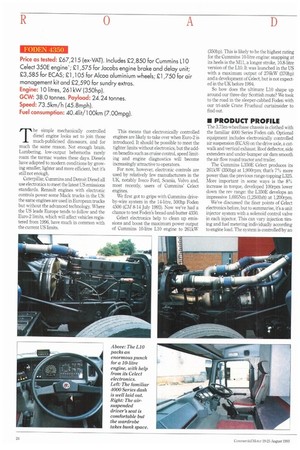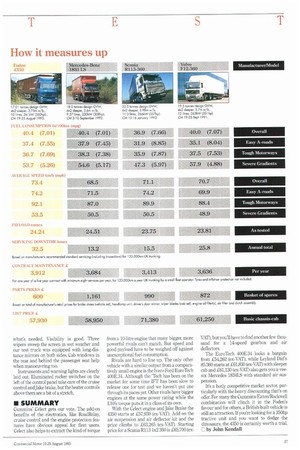FODEN 4350
Page 28

Page 30

Page 31

If you've noticed an error in this article please click here to report it so we can fix it.
Price as tested: £67,215 (ex-VAT). Includes £2,850 for Cummins L10 Celect 350E engine'; £1,575 for Jacobs engine brake and delay unit; £3,585 for ECAS; £1,105 for Alcoa aluminium wheels; £1,750 for air management kit and £2,590 for sundry extras.
Engine: 10 litres, 261kW (350hp).
GCW: 38.0 tonnes. Payload: 24.24 tonnes.
Speed: 73.5km/h (45.8mph).
Fuel consumption: 40.41it/100km (7.00mpg).
The simple mechanically controlled diesel engine looks set to join those much-publicised dinosaurs, and for much the same reason. Not enough brain. Lumbering, low-output behemoths rarely roam the tarmac wastes these days. Diesels have adapted to modern conditions by growing smaller, lighter and more efficient, but it's still not enough.
Caterpillar, Cummins and Detroit Diesel all use electronics to meet the latest US emissions standards, Renault engines with electronic controls power some Mack trucks in the US: the same engines are used in European trucks but without the advanced technology. Where the US leads Europe tends to follow and the Euro-2 limits, which will affect vehicles registered from 1996, have much in common with the current US limits. This means that electronically controlled engines are likely to take over when Euro-2 is introduced. It should be possible to meet the tighter limits without electronics, but the addon benefits such as cruise control, speed limiting and engine diagnostics will become increasingly attractive to operators.
For now, however, electronic controls are used by relatively few manufacturers in the UK, notably Iveco Ford, Scania, Volvo and, most recently, users of Cummins' Celect engines.
We first got to grips with Cummins driveby-v,-ire system in the 14-litre, 500hp Foden 4500 (CM 8-14 July 1993). Now we've had a chance to test Foden's bread-and-butter 4350.
Celect electronics help to clean up emissions and boost the maximum power output of Cummins 10-litre L10 engine to 261kW
(350hp). This is likely to be the highest rating for the Cummins 10-litre engine: snapping at its heels is the M11, a longer stroke, 10.8-litre version of the u.o. It was launched in the US with a maximum output of 276kW (370hp) and a development of Celect, but is not expected in the UK before 1994.
So how does the ultimate L10 shape up around our three-day Scottish route? We took to the road in the sleeper-cabbed Foden with our tri-axle Crane Fruehauf curtainsider to find out.
• PRODUCT PROFILE
The 3.75m-wheelbase chassis is clothed with the familiar 4000 Series Foden cab. Optional equipment includes electronically controlled air suspension (ECAS) on the drive axle, a catwalk and vertical exhaust. Roof deflector, side extenders and under-bumper air dam smooth the air flow round tractor and trailer, The Cummins L350E Celect produces its 261kW (350hp) at 1,900rpm; that's 7% more power than the previous range-topping L325. More important in some ways is the 8% increase in torque, developed 100rpm lower down the rev range: the L350E develops an impressive 1,695Nm (1,2501bft) at 1,200rpm.
We've discussed the finer points of Celect electronics before, but to summarise, it's a unit injector system with a solenoid control valve in each injector. This can vary injection timing and fuel metering individually according to engine load. The system is controlled by an electronic control module (ECM), which receives information about the engine's operational state from a number of sensors.
Celect provides a speed limiter and, like the 4500 we tested recently, the 4350 was set up with gear-down protection. This stops it exceeding 90km/h (56mph) in any gear other than top to prevent driver abuse and unnecessary high engine speeds.
Our test vehicle was also fitted with Cummins Celect RoadRelay. Its functions include logging the amount of fuel used, average fuel consumption, and time spent at idle, in motion and in PTO mode. Information is displayed on a dash-mounted LCD display.
• PRODUCTIVITY
We've long felt that horsepower is a misleading indicator of performance. Take the 4350's overall average speed of 73.4km/h (45.7mph) and compare it with the Foden 4500's similar average of 73.3km/h (45.6mph). Same route, same driver but with 150hp less. Traffic flow and top speed limiters are the great levellers on our mixed route. There's no denying the advantage high power gives in hilly country, but if most of your time is spent on motorways you won't go appreciably faster with more than 400hp under your right foot.
That 1,695Nm (1,2501bft) of torque would not disgrace a 400hp tractor; it's a remarkable achievement to extract this much grunt from a 10-litre engine and this explains why the 4350 was so quick—no similarly powered truck we have tested has covered the ground as rapidly. The hill-climb times confirm those results; again the Foden is significantly quicker up the slopes than similarly powered rivals.
Against this background the overall fuel consumption of 40.4 lit/100km (7.01mpg) is not as disappointing as it seems at first. Performance and high torque come at a price. Even so, we expected better. For a good overall result more than 35.31itilOOkm (8.0mpg) must be logged over the easier sections of the route. As the Foden's best result was 36.71it/100km (7.69mpg) it couldn't hope to match its slower but more frugal rivals. All CM truck testing is carried out fully laden, however, so operators running part laden can expect better results.
A comparatively small engine should offer payload gains and the 4350's 2424 tonnes is only bettered by the less powerful Mercedes 1831 in our comparison charts. Servicing costs are competitive too, with reasonable parts prices but a smaller dealer network than some rivals.
• ON THE ROAD
A torquey engine and Eat, In's fast-changing twin-splitter box got the Foden off to a good start. We pulled away in 2nd on the flat, block shifted to 5th, 7th and usually 9th before splitting top gear.
We've had problems with Foclen's gearshift brake settings before and we had trouble on an enforced hill re-start with the 4350. Flooring the clutch should activate the shift brake when split-shifting. This allows the quick changes necessary on a re-start if crawling up a bank in bottom gear is to be avoided. The 4350 wouldn't deliver in the low gears and the only way to make the upshifts was to "bunny hop"—select the next split and quickly pull the lever into neutral then push it back into gear without using the clutch. It's easier than it sounds but shouldn't be necessary if the shift brake is set up properly.
Compared with the 6x4 rubber-suspended 4500 we tested, the ECAS air-suspended 4350 offered a ride like a magic carpet. In absolute terms it's still on the firm side, even with an air-suspended driver's seat, but it's comfortable and the firmness helps control roll.
A wet track prevented us from carrying out our usual brake testing at MIRA, but the Foden impressed us with its powerful and progressive brakes on the road. Like the 4500, the 4350 was equipped with a Jake brake and delay unit.
With the brake switched on the Jake cuts in automatically a few seconds after lifting off. Inevitably. the Jake isn't as effective on the L10 as on the 14-litre Cummins but it still provides superior retardation to an exhaust brake.
The 14-litre engine also makes a deeper, more satisfying noise than the 10-litre Celect. The L10 is generally not as refined, with turbo whistle the main culprit. Even so, it's not a noisy cab, as our meter readings show.
• CAB COMFORT
Two broad steps with non-slip grates make climbing in relatively easy but, as we've said before, climbing out is more difficult because the large gap between the two steps makes the bottom step difficult to judge on the way down.
The air-suspended driver's seat comes with armrests, inflatable lumbar support and electric bum-wanner for cold mornings. It's adjustable in all the usual directions while the steering wheel's rake and reach can be set to suit.
There's plenty of storage space below the high-mounted bunk for bags, sleeping bags and the like, even though some of the available space is taken up by a tool locker which is accessed from outside behind the passenger side door.
Oddments space is available on the engine cover, in door pockets and the header rail; a box under the driver's seat will house diesel gloves, rags etc. In addition there's a zip-fronted wardrobe behind the drive's seat at the expense of some bunk length. Since most drivers like to sleep with their heads behind the driving seat, we can't understand why the wardrobe isn't on the passenger side.
The bunk foam is thick enough for a comfortable night's sleep, but width is restricted at both ends by cut-ins for the seats, The Foden cab is fine as a rest cab but for extended trips away from home it lacks space. A high roof and greater depth front-to-back are
what's needed. Visibility is good. Three wipers sweep the screen in wet weather and our test truck was equipped with long-distance mirrors on both sides Cab windows in the rear and behind the passenger seat help when manoeuvring too.
Instruments and warning lights are clearly laid out. Illuminated rocker switches on the left of the control panel take care of the cruise control and Jake brake, but the heater controls above them are a bit of a stretch.
• SUMMARY
Cummins' Celect gets our vote. The add-on benefits of the electronics, like RoaclRelay, cruise control and the engine protection features have obvious appeal for fleet users. Celect also helps to extract the kind of torque
from a 10-litre engine that many bigger, more powerful rivals can't match. But speed and good payload have to be weighed off against unexceptional fuel consumption.
Rivals are hard to line up. The only other vehicle with a similar output from a comparatively small engine is the Iveco Ford EuroTech 400E.34. Although the 'Tech has been on the market for some time TT has been slow to release one for test and we haven't put one through its paces yet. Other rivals have bigger engines at the same power rating while the L10's torque puts it in a class of its own.
With the Celect engine and Jake Brake the 4350 starts at £57,930 (ex-VAT). Add on the air suspension and air deflector kit and the price climbs to £63,265 (ex-VAT). Starting price for a Scania R113 4x2 360 is £65,700 (ex
VAT), but you'll have to find another few thousand for a 14-speed gearbox and air deflectors.
The EuroTech 400E.34 looks a bargain from £54,262 (ex-VAT), while Leyland Daf's 85.360 starts at £61,830 (ex-VAT) with sleeper cab and £61,130 (ex-VAT) also gets you a veesix Mercedes 1834LS with standard air suspension.
It's a hotly competitive market sector, particularly with the heavy discounting that's on offer, For many the Cummins/Eaton/Rockwell combination will clinch it in the Foden's favour and for others, a British-built vehicle is still an attraction. If you're looking for a 350hp tractive unit and you want to dodge the dinosaurs, the 4350 is certainly worth a trial. C by John Kendall
















































































